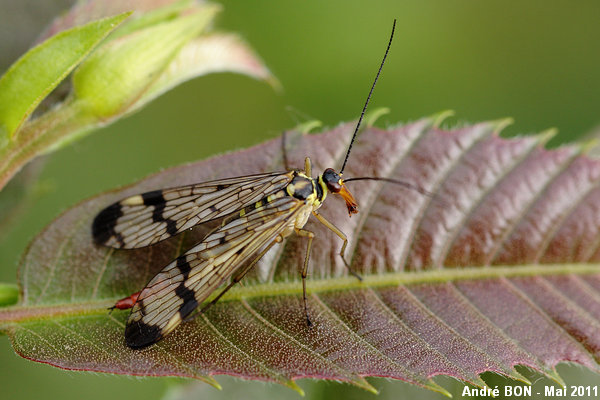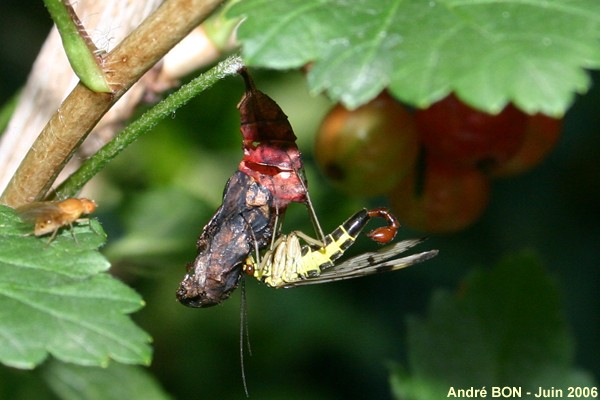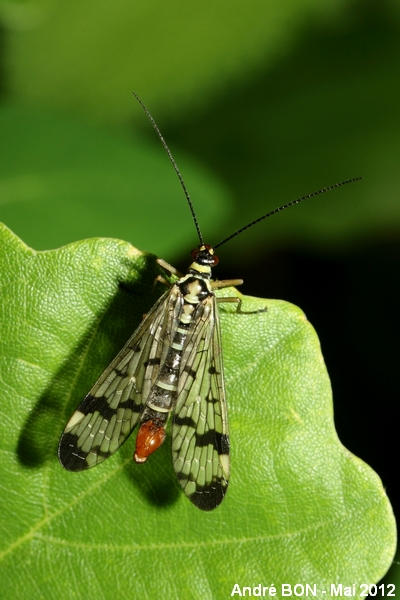



| Common Scorpion Fly (Panorpa communis (Linnaeus, 1758)) |




|
|
Scientific name: Panorpa communis (Linnaeus, 1758) Common name: Common Scorpion Fly French name: Panorpe commune, Mouche scorpion. Order: Mecoptera Family: Panorpidae Wingspan : 20-30 mm. Biotope: Bushes , damp woodlands, parks and gardens. The Common Scorpion Fly prefers damp and shaded places. Geographic area: Widespread in Europe. Observation period : May to August. |
The Common Scorpion flies have a beak-like head extension. The male's abdomen bears the gonopodium which looks like a scorpion's tail. The body is black and yellow. The wings are lengthy with dark spots and blotches. The larvae, which look like caterpillars, live under the ground. The Common Scorpion flies and the larvae feed on dead insects and sometimes on fruits. There are several similar species which are rather difficult to tell apart. This is slightly easier with males based on the shape of the sixth abdominal segment (with a side view), on the shape of the hypovalves on the bulbous appendage and on the wing veins. You can only give indications with females based on the wing patches. Males of the Panorpa communis, Panorpa germanica, Panorpa vulgaris and Panorpa alpina species have a conical-shaped sixth abdominal segment. Males of the Panorpa cognata, Panorpa meridionalis and Panorpa etrusca do not show a conical-shaped sixth abdominal segment. It is almost rectangular and even with the upper part of the segment tip slightly curved upwards. In the communis group, Panorpa alpina, with the wings only showing a few very small patches, can be identified by the sub-costal vein joining the costal vein far before the pterostigma. Panorpa germanica has short and wide hypovalves (they are long and thin on the other members of the communis group). Furthermore Panorpa germanica has very few patches on the wings and does not show any pterostigma stripe completely crossing the fore wing. You need to look at the patches on the wings to tell Panorpa communis and Panorpa vulgaris apart. Panorpa communis has not many patches and the basal patch is missing or reduced so that it is totally included between two veins. Panorpa vulgaris has larger patches on the wings with a rather wide basal patch extending on several cells. In France, in the cognata group, Panorpa meridionalis is only found in the south-western region and Panorpa etrusca is limited to the extreme south-east corner. So, in may regions, a simple side view of a rectangular sixth abdominal segment of a male is enough to tell Panorpa cognata apart. There are many patches on the wings and there is a marginal patch before the pterostigma. |
| [To know more about the Common Scorpion Fly] [Next picture] [Top] |

|
Here is one female with the typical wing layout of Panorpa communis. This one is not matching Panorpa cognata as the marginal patch is missing. It is not matching the other species of the same group because of the geographical location. The sub-costal vein joins the costal vein near the pterostigma, so this is not Panorpa alpina. You can see a pterostigma stripe completely crossing the fore wing, this is not the case on Panorpa germanica. The lack of a large basal patch allows to discard Panorpa vulgaris. |
| [To know more about the Common Scorpion Fly] [Next picture] [Previous picture] [Top] |

|
The Comma butterfly's pupa, I found in my garden, will never become a beautiful imago. This Common Scorpion Fly took it for dinner. |
| [To know more about the Common Scorpion Fly] [Next picture] [Previous picture] [Top] |

|
I have observed many Scorpion flies in my garden and in woodlands. |
| [To know more about the Common Scorpion Fly] [Previous picture] [Top] |

|
The identification of this species is based on layout of the spots on the wings. |